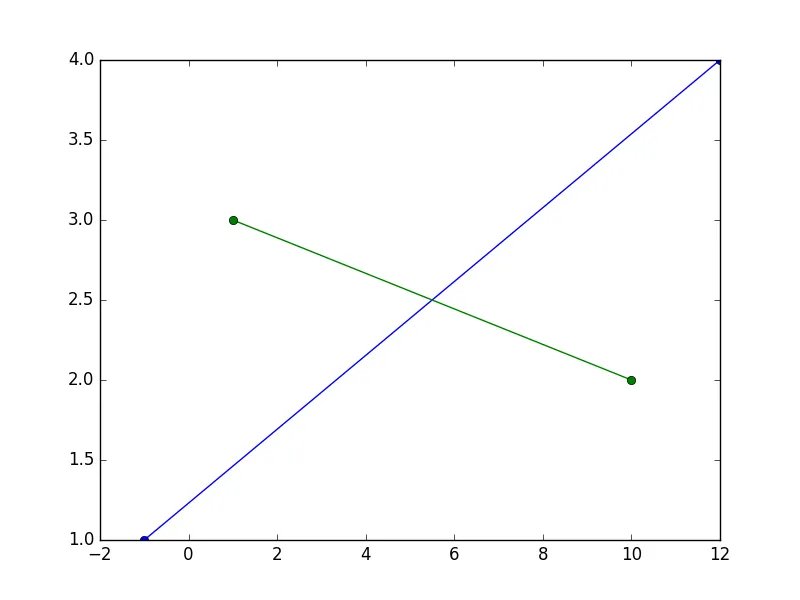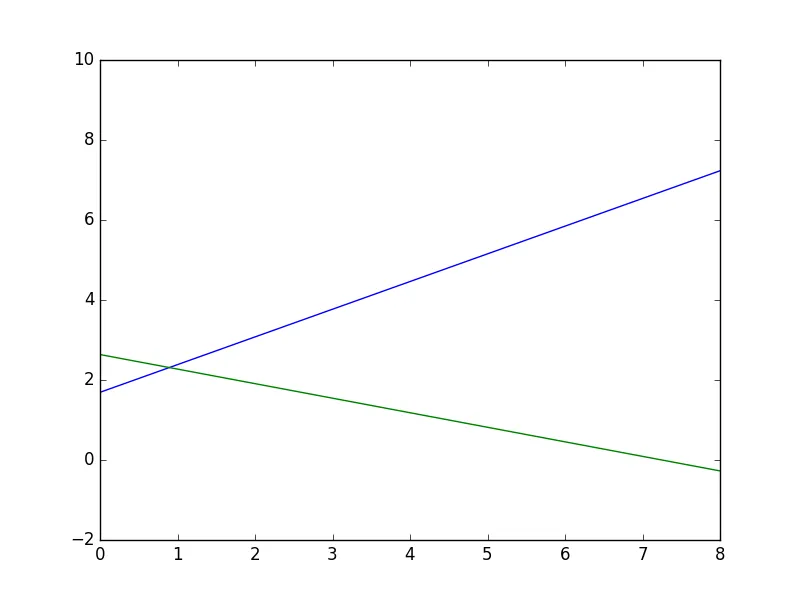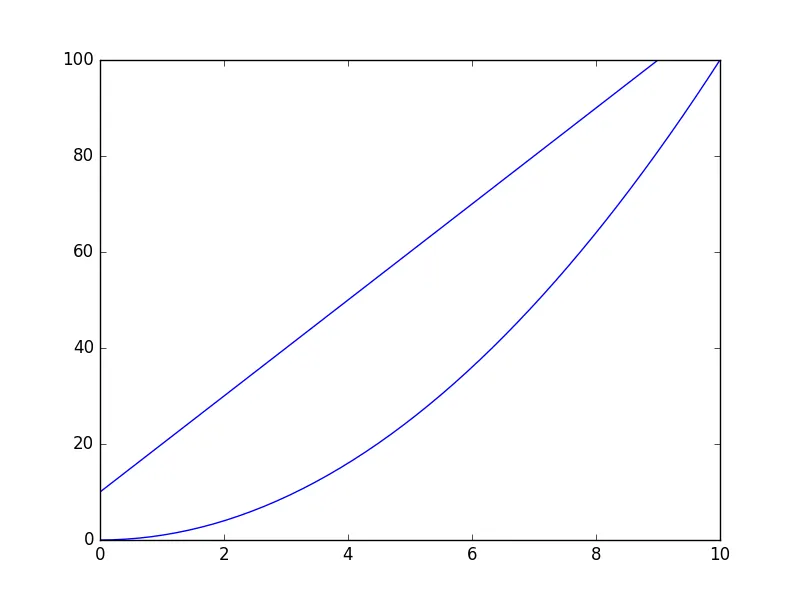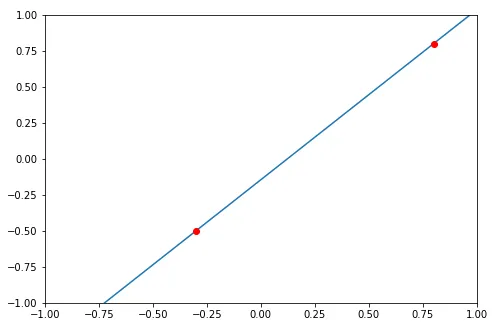我找不到使用matplotlib Python库绘制任意线条的方法。 这个库可以绘制水平和垂直线条(例如使用matplotlib.pyplot.axhline和matplotlib.pyplot.axvline),但是我不知道如何通过两个给定点(x1, y1) 和(x2,y2)绘制一条直线。有没有办法? 有没有简单的方法?
如何使用matplotlib绘制一条线?
2
这将绘制经过点(-1, 1)和(12, 4)的一条直线,以及经过点(1, 3)和(10, 2)的另一条直线。
x1是第一条线段上点的x坐标,y1是相应点的y坐标--x1和y1中的元素必须按顺序排列。
x2和y2对于另一条线段也是如此。
import matplotlib.pyplot as plt
x1, y1 = [-1, 12], [1, 4]
x2, y2 = [1, 10], [3, 2]
plt.plot(x1, y1, x2, y2, marker = 'o')
plt.show()
我建议您花些时间阅读/学习 matplotlib 网站上的基本教程,以熟悉该库。
如果我不想要线段怎么办?
[编辑]:
正如 @thomaskeefe 所示,从 matplotlib 3.3 开始,现在内置了一个便利函数:plt.axline((x1, y1), (x2, y2)),因此下面的方法已过时。
没有直接的方法使线条无限延伸... matplotlib 会重新调整/缩放绘图区域,使最远点在边界上而另一个点在内部,实际上画出线段;或者您必须选择超出所需设置为可见表面的边界的点,并设置 x 和 y 轴的限制。
做法如下:
import matplotlib.pyplot as plt
x1, y1 = [-1, 12], [1, 10]
x2, y2 = [-1, 10], [3, -1]
plt.xlim(0, 8), plt.ylim(-2, 8)
plt.plot(x1, y1, x2, y2, marker = 'o')
plt.show()
5
axhline 和 axvline 可以创建“无限”的线条。但是,你提出的解决方案对我来说有问题,因为我很可能需要通过在显示区域内的点来绘制直线。当然,我可以创建一个端点位于显示区域外的长线段,但这很不方便(我需要计算端点),也不美观(我需要一条线,但我画了一条线段并尝试平移它以使其看起来像一条线,并计算我不需要的端点)。 - Alexey我正在检查ax.axvline的工作原理,并编写了一个类似于其思想的小函数:
import matplotlib.pyplot as plt
import matplotlib.lines as mlines
def newline(p1, p2):
ax = plt.gca()
xmin, xmax = ax.get_xbound()
if(p2[0] == p1[0]):
xmin = xmax = p1[0]
ymin, ymax = ax.get_ybound()
else:
ymax = p1[1]+(p2[1]-p1[1])/(p2[0]-p1[0])*(xmax-p1[0])
ymin = p1[1]+(p2[1]-p1[1])/(p2[0]-p1[0])*(xmin-p1[0])
l = mlines.Line2D([xmin,xmax], [ymin,ymax])
ax.add_line(l)
return l
如果您运行以下代码,您将意识到它是如何工作的。该线将跨越整个绘图范围(无论其大小如何),并且该线的创建不依赖于轴内任何数据点,而仅依赖于您需要指定的两个固定点。
import numpy as np
x = np.linspace(0,10)
y = x**2
p1 = [1,20]
p2 = [6,70]
plt.plot(x, y)
newline(p1,p2)
plt.show()
7
ymin 和 ymax,并且可能会出现除以 0 的情况。 - Alexeymatplotlib 能够绘制任何线条。我正在研究平面上一些点对的集合,并希望通过它们绘制直线以查看它们如何相交。 - Alexey根据@Alejandro的答案:
- 如果您想要添加一条线到现有的
Axes(例如散点图),并且 - 您已知期望线的斜率和截距(例如回归线),并且
- 您希望该线覆盖整个可见X范围(已经计算出),并且
- 您希望使用面向对象的接口(而不是
pyplot)。
那么您可以这样做(现有的ax中已存在Axes):
# e.g. slope, intercept, r_value, p_value, std_err = scipy.stats.linregress(xs, ys)
xmin, xmax = ax.get_xbound()
ymin = (xmin * slope) + intercept
ymax = (xmax * slope) + intercept
l = matplotlib.lines.Line2D([xmin, xmax], [ymin, ymax])
ax.add_line(l)
a和b。我们想要在每个a[i]和b[i]之间绘制线段。解决方法如下:
Solution 1
ab_pairs = np.c_[a, b]
plt_args = ab_pairs.reshape(-1, 2, 2).swapaxes(1, 2).reshape(-1, 2)
ax.plot(*plt_args, ...)
例子:
np.random.seed(0)
n = 32
a = np.random.uniform(0, 1, (n, 2))
b = np.random.uniform(0, 1, (n, 2))
fig, ax = plt.subplots(figsize=(3, 3))
ab_pairs = np.c_[a, b]
ab_args = ab_pairs.reshape(-1, 2, 2).swapaxes(1, 2).reshape(-1, 2)
# segments
ax.plot(*ab_args, c='k')
# identify points: a in blue, b in red
ax.plot(*a.T, 'bo')
ax.plot(*b.T, 'ro')
plt.show()
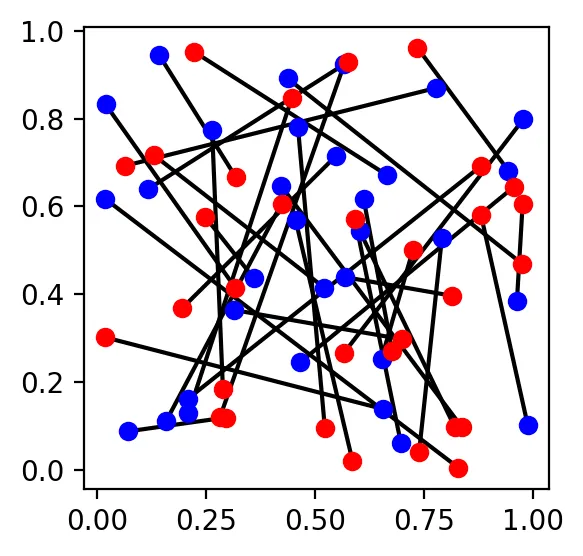
解决方案2
上述方法会创建许多matplotlib.lines.Line2D。如果您想要一条单独的线,可以通过在一对点之间插入NaN来实现:
ax.plot(*np.c_[a, b, a*np.nan].reshape(-1, 2).T, ...)
例子:
# same init as example above, then
fig, ax = plt.subplots(figsize=(3, 3))
# segments (all at once)
ax.plot(*np.c_[a, b, a*np.nan].reshape(-1, 2).T, 'k')
# identify points: a in blue, b in red
ax.plot(*a.T, 'bo')
ax.plot(*b.T, 'ro')
plt.show()
(与上图相同)。
在这里提到另一种选择。
您可以使用numpy.polyfit()计算系数,并将系数输入numpy.poly1d()。此函数可以使用系数构造多项式,您可以在此处找到更多示例:
https://docs.scipy.org/doc/numpy-1.13.0/reference/generated/numpy.poly1d.html
假设给定两个数据点(-0.3,-0.5)和(0.8,0.8)。
import numpy as np
import matplotlib.pyplot as plt
# compute coefficients
coefficients = np.polyfit([-0.3, 0.8], [-0.5, 0.8], 1)
# create a polynomial object with the coefficients
polynomial = np.poly1d(coefficients)
# for the line to extend beyond the two points,
# create the linespace using the min and max of the x_lim
# I'm using -1 and 1 here
x_axis = np.linspace(-1, 1)
# compute the y for each x using the polynomial
y_axis = polynomial(x_axis)
fig = plt.figure()
axes = fig.add_axes([0.1, 0.1, 1, 1])
axes.set_xlim(-1, 1)
axes.set_ylim(-1, 1)
axes.plot(x_axis, y_axis)
axes.plot(-0.3, -0.5, 0.8, 0.8, marker='o', color='red')
希望这有所帮助。
以下是需要翻译的内容:
2
原文链接
